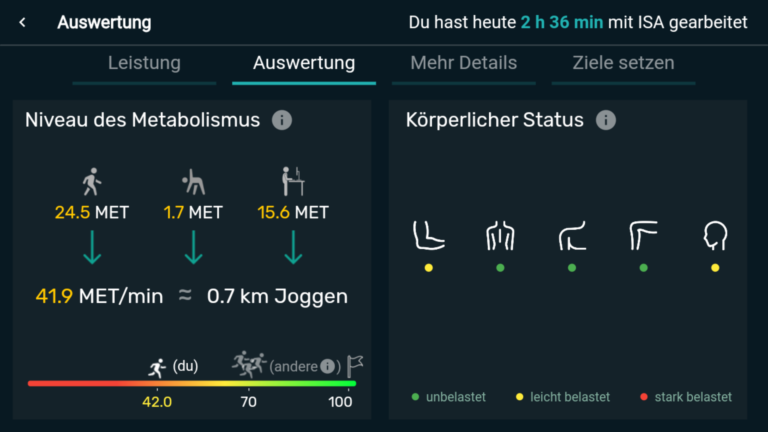MSK disorders are the main cause of reduced quality of life worldwide. In Germany, they cause the most days of sick leave and account for over 20% of all sick days.
Imagine a digital physiotherapist focused entirely on your health - that's Isa.
Over a longer period of time, Isa accompanies and analyses your behaviour in the workplace. She gives you individual advice on how to improve the way you work and supports you with sound methods to establish healthy behaviour.

Low-threshold health promotion for ergonomics, movement & vitality
Using a depth sensor, movement and ergonomic behaviour are captured in compliance with data protection regulations.

Artificial intelligence is used to create an individualised load profile of the body in real time.
Coaching based on findings from health & behavioural science.


We will be happy to provide the comprehensive data concept jointly developed by Fraunhofer IOSB, FZI and DeepCare on request.
Entscheidend für die Wirksamkeit ist, dass die Anwendung tatsächlich genutzt wird. Daran scheitern viele digitale Ansätze. Isa ist anders…
Always present: Isa simply walks alongside without you having to pick up your smartphone first.
Plug and Play: Put it down, switch it on, it runs. No initialisation effort.
Focus on health: Isa does not mix with work content on the PC or private distractions of the smartphone.
Precise detection: The highly accurate sensor enables a competent assessment of health behaviour.
Individual: Based on the actual health burden, Isa can guide holistically and competently.
Data security: Due to the closed system, there are no security gaps.
Please let the following questions run through your mind:
If your smartphone is on your desk all day and a health app is continuously communicating with you, would you let private apps distract you from work?
Do you agree that your smartphone or webcam on your PC (both connected to the internet) is watching you via camera throughout your working day?
What do you think about more pop-ups on your PC while you work?
A high dependence on smartphones has been proven to have a negative impact on mental and physical health as well as cognitive performance. Doesn't a health app that motivates you to continuously use your smartphone therefore represent a contradiction?
These classical approaches are important to sensitise and train employees for health in the workplace. However, they are only selective measures that take place outside the working day. As a result, they have limited impact on people's behaviour during their long hours in the office.
In contrast, Isa accompanies the employees over a longer period of time and is constantly available to contribute individually to healthy behaviour. This tackles the problem from the ground up. On the one hand, Isa helps to prevent health risks from the very beginning. On the other hand, the long-term accompaniment enables employees to develop and consolidate new healthy behaviours
Absolutely! It is one of the core functionalities of Isa to guarantee the optimal use of a height-adjustable desk. This feature can be easily switched on or off in Isa's settings, depending on the availability of a height-adjustable desk.
Yes, we work with various health insurance companies that use Isa as part of their prevention and health promotion services in accordance with §20 SGB V in companies. However, this is only done after individual consultation with the respective health insurance companies.
We attach great importance to you being able to work in the best possible way! The Isa interaction concept is very discreet, intuitive and can be adjusted individually. However, if Isa detects a major health problem during your work, you will be interrupted from time to time. However, this is done for the good of your health and thus serves your long-term performance.
No. The sensor only creates an anonymous 3D silhouette of the person at the desk. This does not make it possible to identify people.
Isa ensures that you still feel good after a long day at work. In addition, Isa helps you prevent musculoskeletal disorders (e.g. back pain) and serious long-term diseases such as diabetes.
Enough to experience a noticeable health benefit. On the other hand, not so many that you are distracted from your work. Most importantly, Isa adapts to your personal habits and moves further and further into the background when you are healthy.
Of course. You benefit from constant new functions and programmes that are made available to you.
Yes. All functions can be switched on and off or set individually.
No, Isa is not a medical device.